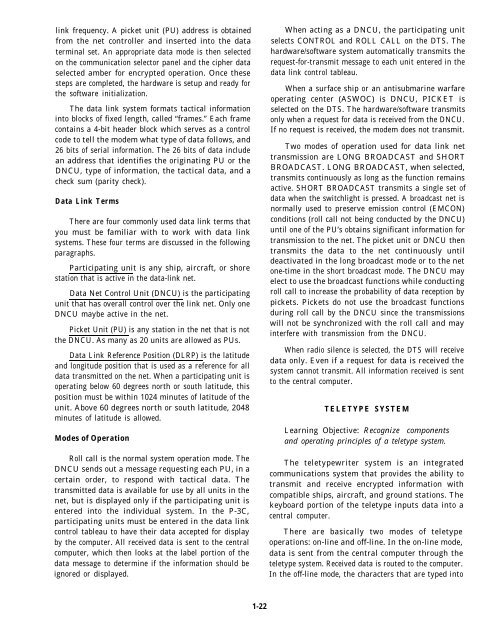Aviation Electronics Technician 1 - Historic Naval Ships Association
Aviation Electronics Technician 1 - Historic Naval Ships Association
Aviation Electronics Technician 1 - Historic Naval Ships Association
You also want an ePaper? Increase the reach of your titles
YUMPU automatically turns print PDFs into web optimized ePapers that Google loves.
link frequency. A picket unit (PU) address is obtainedfrom the net controller and inserted into the dataterminal set. An appropriate data mode is then selectedon the communication selector panel and the cipher dataselected amber for encrypted operation. Once thesesteps are completed, the hardware is setup and ready forthe software initialization.The data link system formats tactical informationinto blocks of fixed length, called “frames.” Each framecontains a 4-bit header block which serves as a controlcode to tell the modem what type of data follows, and26 bits of serial information. The 26 bits of data includean address that identifies the originating PU or theDNCU, type of information, the tactical data, and acheck sum (parity check).Data Link TermsThere are four commonly used data link terms thatyou must be familiar with to work with data linksystems. These four terms are discussed in the followingparagraphs.Participating unit is any ship, aircraft, or shorestation that is active in the data-link net.Data Net Control Unit (DNCU) is the participatingunit that has overall control over the link net. Only oneDNCU maybe active in the net.Picket Unit (PU) is any station in the net that is notthe DNCU. As many as 20 units are allowed as PUs.Data Link Reference Position (DLRP) is the latitudeand longitude position that is used as a reference for alldata transmitted on the net. When a participating unit isoperating below 60 degrees north or south latitude, thisposition must be within 1024 minutes of latitude of theunit. Above 60 degrees north or south latitude, 2048minutes of latitude is allowed.Modes of OperationRoll call is the normal system operation mode. TheDNCU sends out a message requesting each PU, in acertain order, to respond with tactical data. Thetransmitted data is available for use by all units in thenet, but is displayed only if the participating unit isentered into the individual system. In the P-3C,participating units must be entered in the data linkcontrol tableau to have their data accepted for displayby the computer. All received data is sent to the centralcomputer, which then looks at the label portion of thedata message to determine if the information should beignored or displayed.When acting as a DNCU, the participating unitselects CONTROL and ROLL CALL on the DTS. Thehardware/software system automatically transmits therequest-for-transmit message to each unit entered in thedata link control tableau.When a surface ship or an antisubmarine warfareoperating center (ASWOC) is DNCU, PICKET isselected on the DTS. The hardware/software transmitsonly when a request for data is received from the DNCU.If no request is received, the modem does not transmit.Two modes of operation used for data link nettransmission are LONG BROADCAST and SHORTBROADCAST. LONG BROADCAST, when selected,transmits continuously as long as the function remainsactive. SHORT BROADCAST transmits a single set ofdata when the switchlight is pressed. A broadcast net isnormally used to preserve emission control (EMCON)conditions (roll call not being conducted by the DNCU)until one of the PU’s obtains significant information fortransmission to the net. The picket unit or DNCU thentransmits the data to the net continuously untildeactivated in the long broadcast mode or to the netone-time in the short broadcast mode. The DNCU mayelect to use the broadcast functions while conductingroll call to increase the probability of data reception bypickets. Pickets do not use the broadcast functionsduring roll call by the DNCU since the transmissionswill not be synchronized with the roll call and mayinterfere with transmission from the DNCU.When radio silence is selected, the DTS will receivedata only. Even if a request for data is received thesystem cannot transmit. All information received is sentto the central computer.TELETYPE SYSTEMLearning Objective: Recognize componentsand operating principles of a teletype system.The teletypewriter system is an integratedcommunications system that provides the ability totransmit and receive encrypted information withcompatible ships, aircraft, and ground stations. Thekeyboard portion of the teletype inputs data into acentral computer.There are basically two modes of teletypeoperations: on-line and off-line. In the on-line mode,data is sent from the central computer through theteletype system. Received data is routed to the computer.In the off-line mode, the characters that are typed into1-22
















